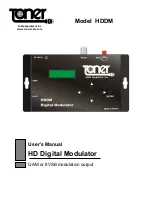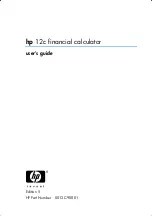
Graph
expr [,var] (function graph)
xExpr,yExpr [,var] (parametric graph)
expr [,
θ
var] (polar graph)
expr [,xvar] [,yvar] (3D graph)
Graph the expr argument with the current Graph
mode. Expressions created with Graph (or
Table) are assigned increasing function
numbers starting with 1. Modify or delete them
with the [F4] Header function in the table
display. The currently selected Y= functions are
not graphed. The independent variable of the
current graph mode is used if a var argument is
omitted. Use ClrGraph to clear the functions, or
start the Y= editor to enable the system
variables.
▶
▶
▶
▶
Hex
integer1
▶
Hex
Convert integer1 to hexadecimal. Non-decimal
integers must be preceeded with 0b or 0h.
Arguments larger than 32-bit signed values are
reduced with symmetric modulo operation.
identity(expr)
Return identitiy matrix with dimension of expr.
If
If BooleanExpr : statement
Execute single statement if BooleanExpr
evaluates to TRUE.
If BooleanExpr then : block :EndIf
Execute block if BooleanExpr evaluates to
TRUE.
If BooleanExpr then : block1
Else : block2 : EndIf
If BooleanExpr evaluates to TRUE, execute
block1 but not block2; otherwise execute block2
but not block1.
If BooleanExpr1 Then : block1
ElseIf BooleanExpr2 Then : block2
...
ElseIf BooleanExprN Then : blockN
EndIf
Execute block1 only if BooleanExpr1 evaluates
to TRUE, execute block2 only if BooleanExpr2
evaluates to TRUE, etc.
imag()
(expr), (list), (matrix)
Return the imaginary part of the argument. All
undefined variables are treated as real
variables.
Input [[promptString,]var]
If no arguments, pause program execution,
display the Graph screen and update xc and yc
(or rc and
θ
c in Polar mode) by positioning the
cursor.
If argument var is used, the program pauses,
displays promptString on the Program I/O
screen and waits for the entry of an expression.
The expression is stored in var. If promptString
is omitted, "?" is displayed for the prompt.
InputStr [promptString,]var
Pause program execution, display promptString
on the Program I/O screen and wait for the entry
of an expression, which is stored as a string in
var. "?" is displayed as a prompt if promptStrin
is omitted.
inString(sourceString,targetString[,start])
Return position at which targetString starts in
sourceString. The search for targetString begins
at character number start, if start is used. start is
1 by default.
int()
(expr), (list), (matrix)
Return the greatest integer that is less than or
equal to the argument, which may be real or
complex. int() is identical to floor().
intDiv()
(number1,number2), (list1,list2),
(matrix1,matrix2)
Return the signed integer part of the first
argument divided by the second argument.
integrate
See
·
().
iPart()
(number), (list), (matrix)
Return the integer part of the argument, which
may be real or complex.
isPrime(number)
Return True or False to indicate if number is
prime. Display error message if number has
more than about 306 digits and no factors less
than or equal to 1021.
15 - 10
Summary of Contents for TI-92+
Page 52: ...Component side of PCB GraphLink I O connector detail 1 41...
Page 53: ...LCD connector detail PCB switch side 1 42...
Page 54: ...Key pad sheet contact side Key pad sheet key side 1 43...
Page 55: ...Key cap detail 1 44...
Page 57: ...Component side of PCB with shield removed A detail view of the intergrated circuits 1 46...
Page 410: ...void extensionroutine2 void Credit to Bhuvanesh Bhatt 10 4...















































